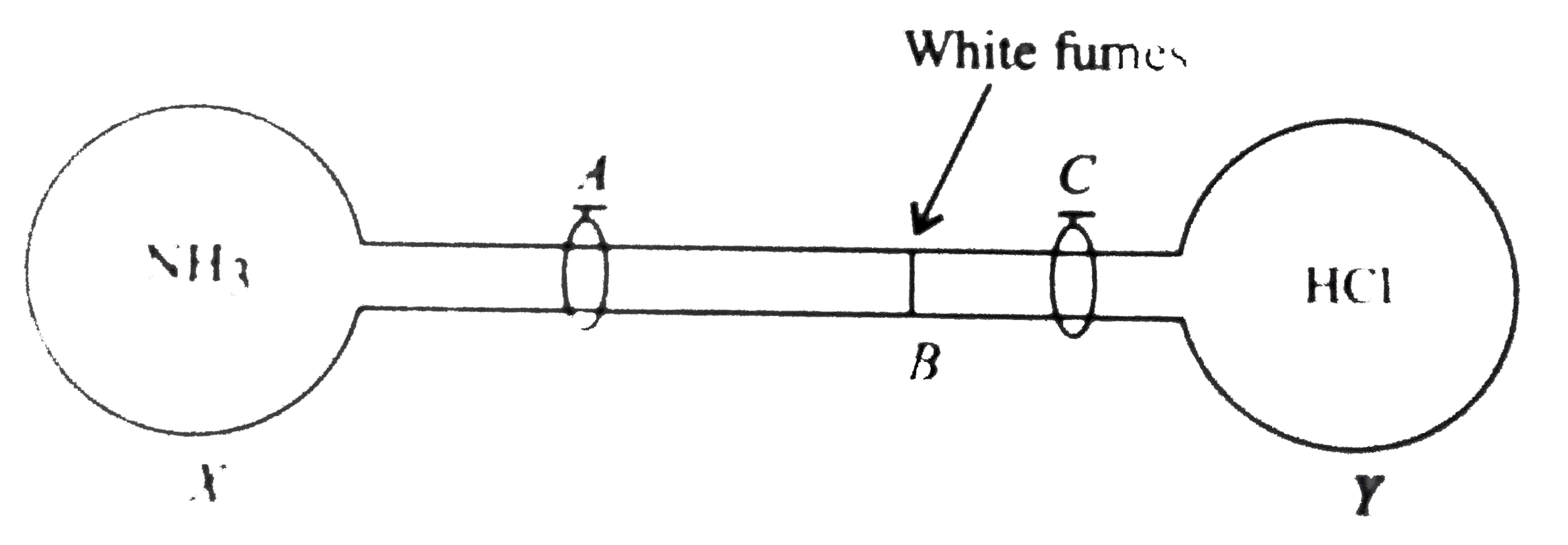The constant motion and high velocities of gas particles lead to some important practical consquences. One such consquences is that gases mix rapidly when they come in contact. Take the stopper off a bottle of perfume, for instance, and the odour will spread rapidly through the room as perfume molecules mix with the molecules in the air. This mixing of different gases by random molecular motion and with frequent collision is called diffusion. A similar process in which gas molecules escape without collision through a tiny hole into a vacuum is called effusion. Both the processes follow Graham's law which is mathematically put as r∝√1/d. The average distance travelled by molecules between successive collisions is called mean free path.
Answer the following questions on the basis of the above information:
The stop cocks of the bulbs X (containing NH3) and Y (containing HCl), both under indentical conditions, are opened simultaneously. White fumes of NH4Cl, are formed at point B. If AB=36.5cm, then BC is approximately

18.0cm
25.0cm
20.0cm
36.5cm
rHClrNH3=μHClμNH3=√1736.5=0.682
∴MuHCl=0.682×μNH3
∴ Average distance travelled by HCl=0.682× Average distance travelled by NH3
0.682×36.5=24.9≈25.0cm
Topper's Solved these Questions
- STATES OF MATTERBook:CENGAGE CHEMISTRY ENGLISHChapter:STATES OF MATTERExercise:Exercises (Multiple Correcttype)
Explore 32 Videos
- STATES OF MATTERBook:CENGAGE CHEMISTRY ENGLISHChapter:STATES OF MATTERExercise:Exercises (Single Correct)
Explore 85 Videos
- STATES OF MATTERBook:CENGAGE CHEMISTRY ENGLISHChapter:STATES OF MATTERExercise:Linked Comprehensive
Explore 2 Videos
- SOME BASIC CONCEPTS AND MOLE CONCEPTBook:CENGAGE CHEMISTRY ENGLISHChapter:SOME BASIC CONCEPTS AND MOLE CONCEPTExercise:Archives Subjective
Explore 11 Videos
- STOICHIOMETRYBook:CENGAGE CHEMISTRY ENGLISHChapter:STOICHIOMETRYExercise:Archives Subjective
Explore 33 Videos
Similar Questions
The constant motion and high velocities of gas particles lead to some important practical consquences. One such consquences is that gases mix rapidly when they come in contact. Take the stopper off a bottle of perfume, for instance, and the odour will spread rapidly through the room as perfume molecules mix with the molecules in the air. This mixing of different gases by random molecular motion and with frequent collision is called diffusion. A similar process in which gas molecules escape without collision through a tiny hole into a vacuum is called effusion. Both the processes follow Graham's law which is mathematically put as r∝√1/d. The average distance travelled by molecules between successive collisions is called mean free path.
Answer the following questions on the basis of the above information:
Select the correct statement(s).
View SolutionPerfumes are
View Solution
Knowledge Check
The particles are in constant random motion due to
Ainter-particle spaceBinter-particle attractionCkinetic energyDheatAccording to the kinetic theory of gases, in an ideal gas, between two successive collisions, a gas molecule travels
Ain a circular pathBin a wavy pathCin a straight line pathDwith an accelerated velocity.
Name some important greenhouse gases.
View SolutionThe collision taking place among gas molecules depends upon
View SolutionExplain the following:
Gases can mix up freely with one another.
View SolutionWhen the stopper of a bottle full of hydrogen chloride gas is opened there are fumes in air? Explain why?
View SolutionHow are the different types of velocities of a gas molecules related with one another?
View SolutionWhich one of the following parts of gases contains the same number of molecules?
View Solution
